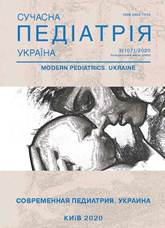Noninvazive ultrasound markers diagnostics secondary wrinkling kidney as a result of vesicoureteral reflux
Keywords:
vesicoureteral reflux, wrinkling of the kidney, ultrasound markersAbstract
Purpose: search for ultrasound markers of kidney wrinkling.Clinical case. The article presents a clinical observation of a 10-year-old child with vesicoureteral reflux, which led to the secondary wrinkling of the kidney, the discussion of which included anamnestic data, laboratory and instrumental research methods, and diagnostic criteria for the disease. The child was examined according to the standards of nephrological patients. The author of the article performed an ultrasound examination of the bladder and kidneys with Doppler. Modern ultrasound and Doppler markers of vesicoureteral reflux in children are covered.
Conclusions. The use of captured ultrasound features allows early non-invasive diagnosis of secondary renal wrinkling due to vesicoureteral reflux and its timely treatment.
Surveys were conducted in compliance with bioethics, the authors obtained informed parents consent to conduct research.
No conflict of interest was declared by the authors.
References
Minakova V. (2017). Markers level of endothelial dysfunction (endotelin-1 and nitrogen oxide) in blood syrovists and albuminuria in children with erythrocyturia. Ukrainian Journal of Nephrology and Dialysis. 3(55): 49–54.
Pleshkova EM, Zernova NI. (2018). Diagnosticheskij poisk puzyrno-mochetochnikovogo refljuksa u detej. Smolenskij medicinskij al'manah. 4: 28–30.
Tokarchuk NI, Odarchuk IV, Zayichko NV. (2015). Аnalysis of education indicators of fibrosis in pyelonephritis on the background of vesicoureteral reflux in children of early age. Sovremennaya Pediatriya. 6(70): 93–96. https://doi.org/10.15574/SP.2015.70.93
Khimion LV, Tymoshchuk LS, Rybytska MO. (2016). Znachennia funktsionalnoho nyrkovoho rezervu pry esentsialnii arterialnii hipertenzii. Simeina Medytsyna №4(66): 81–84.
Derrick L Johnston, Aslam H Qureshi, Rhys W Irvine. (2016). Contemporary Management of Vesicoureteral Reflux. Pediatric Nephrology. 2;2: 82–93. https://doi.org/10.1007/s40746-016-0045-9; PMid:27570729 PMCid:PMC4996282
Herbst KW, Corbett ST, Lendvay TS, Caldamone AA. (2014). Recent trends in the surgical management of primary vesicoureteral reflux in the era of dextranomer/hyaluronic acid. J Urol.191(5): 1628–33. https://doi.org/10.1016/j.juro.2013.09.055; PMid:24679885
Kristoffer Lindskov Hansen, Michael Bachmann Nielsen, Caroline Ewertsen. (2016). Ultrasonography of the Kidney: A Pictorial Review. Diagnostics. 6(1),2. https://doi.org/10.3390/diagnostics
Lee He. (2015). The diagnosis of febrile urinary tract infection in children may be facilitated by urinare biomarkers. Pediatr Nephrol. 30: 123–130. https://doi.org/10.1007/s00467-014-2905-5; PMid:25127917
Strippoli R, Moreno0Vicente R. (2016). Molecular Mechanisms Underlying Peritoneal EMT and Fibrosis (Electronic resource). Stem Cells International. https://doi.org/10.1155/2016/3543678; PMid:26941801 PMCid:PMC4752998
Turk C, Petrik A, Sarica K, Seitz C et al. (2016, Mar). Eau guidelines on diagnosis and conservative management of urolithiasis. Eur Urol. 69(3): 468–74. https://doi.org/10.1016/j.eururo.2015.07.040; PMid:26318710
Williams G, Hodson EM, Craig JC. (2019). Interventions for primary vesicoureteric reflux (Review). Cochrane Database of Systematic Reviews, Issue 2. Art. №.:CD001532 https://doi.org/10.1002/14651858.CD001532.pub5; PMCid:PMC6380991.
Downloads
Issue
Section
License
The policy of the Journal “MODERN PEDIATRICS. UKRAINE” is compatible with the vast majority of funders' of open access and self-archiving policies. The journal provides immediate open access route being convinced that everyone – not only scientists - can benefit from research results, and publishes articles exclusively under open access distribution, with a Creative Commons Attribution-Noncommercial 4.0 international license (СС BY-NC).
Authors transfer the copyright to the Journal “MODERN PEDIATRICS. UKRAINE” when the manuscript is accepted for publication. Authors declare that this manuscript has not been published nor is under simultaneous consideration for publication elsewhere. After publication, the articles become freely available on-line to the public.
Readers have the right to use, distribute, and reproduce articles in any medium, provided the articles and the journal are properly cited.
The use of published materials for commercial purposes is strongly prohibited.

